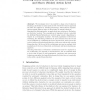13 search results - page 2 / 3 » Behavioral diversity measures for Evolutionary Robotics |
CEC
2007
IEEE
13 years 11 months ago
2007
IEEE
Abstract— Designing effective behavioral controllers for mobile robots can be difficult and tedious; this process can be circumvented by using unsupervised learning techniques w...
IWINAC
2007
Springer
13 years 11 months ago
2007
Springer
We investigate how it is possible to shape robot behaviour adopting a molecular or molar point of view. These two ways to approach the issue are inspired by Learning Psychology, wh...
GECCO
2009
Springer
13 years 9 months ago
2009
Springer
Encouraging exploration, typically by preserving the diversity within the population, is one of the most common method to improve the behavior of evolutionary algorithms with dece...
EVOW
2008
Springer
13 years 6 months ago
2008
Springer
Abstract. This contribution studies speciation from the standpoint of evolutionary robotics (ER). A common approach to ER is to design a robot’s control system using neuro-evolut...
BIBM
2008
IEEE
13 years 11 months ago
2008
IEEE
We present new and novel insights into the behavior of two maximum parsimony heuristics for building evolutionary trees of different sizes. First, our results show that the heuris...

